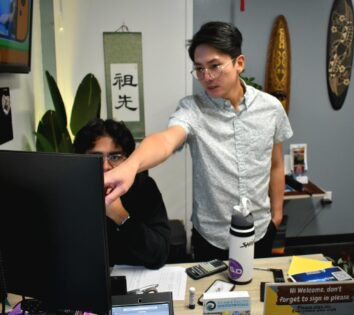The Asian & Pacific Cultural Center opened in Jan. 2023
The Asian American and Pacific Islander community at CSUDH is growing slowly, but steadily. So, too, are the calls from AAPI Toros for more dedicated cultural spaces on campus.
AAPI enrollment at Dominguez Hills has seen a small increase, according to the university’s most recent Fact Sheet – from 7.8 percent during the 2021-22 school year to 8.4 percent now. The Asian & Pacific Culture Center opened last spring in Welch Hall, under the direction of CSUDH staff member Nathan Nguyen. There are now a total of six culture and identity spaces at Dominguez Hills.
Through the APCC, Nguyen hopes to boost the performance and achievement of AAPI students on campus. This includes consistently improving retention rates every year, ensuring students graduate on time, and increasing overall AAPI student enrollment by at least 10 percent. Making sure students feel engaged, supported, and seen at Dominguez Hills is also paramount – it’s why Nguyen has been at the forefront of organizing cultural events on campus.
“To see that our students continue to want to engage and they care about a lot of different things and they’re always advocating for different things too and so for me that’s really rewarding,” Nguyen said.
Before the APCC had a dedicated meeting space, AAPI students would borrow spaces and other facilities throughout campus. The group also had to organize a lot of off-campus activities to maintain a sense of community. When the APCC opened in January 2023, Nguyen said he was told that it would be a temporary space but now, he’s unsure of when a permanent location on campus would become available – or if it would be located near the other cultural centers.

The APCC is a bustling spot, despite having only 19 actual places to sit – between 40 and 50 students stop by the space every hour. Nguyen noted that having more space would help foster community among students.
“It would allow for us to do more programming in the center,” he said. Another APCC staff member, Russell Legaspi, echoed the need for additional accommodations. He described the current space as being “a little bit beyond capacity.”
“Comparing it to now, there has been a significant growth,” said Legaspi, a fifth-year medical technology student. “They have provided the space and we’re very grateful for that.” Legaspi added that he has seen significant progress on campus and in the community.
Mataniu Ulale, a third-year student majoring in art, and the current club president of Oceania, an organization cultivating excellence among Pacific Islanders in academia shares the same sentiment.
“The APCC has supported all of our events and have given us their space to hold our events,” said Mataniu Ulale, a third-year art student and the president of OCEANIA, a dedicated Pacific Islander cultural student group. “The APCC should have a bigger space and also be located in LSU with the other cultural centers.”
The APCC is decorated with Ulale’s art, and she said she appreciates having the space to showcase work that is so intertwined with her identity. Ulale said Pacific Islanders encounter a lot of barriers before, during, and even after attending college. She said this could be attributed to a few factors, including moral and cultural values, family pressure, and financial constraints – Pacific Islander students sometimes put their education on hold to focus on providing for their families.
It’s not just AAPI Toros advocating for more space. Frank Zalazar, a fourth-year computer technology student, said he has a strong interest in AAPI culture and enrolls in classes at Dominguez Hills to learn more. Zalazar, who visited Japan last month, feels CSUDH should do even more to amplify AAPI voices on campus.
“I do think there should be more resources put into the center and they should be receiving the same recognition on our campus as any other ethnic community,” Zalazar said.
The availability and allocation of campus resources is top of mind for Nguyen, too, especially as more AAPI students choose to pursue their education at Dominguez Hills.
He said, “I also hope that we will be in a more centralized location near to our other culture and identity centers so that we can cross-collaborate with one another.”

